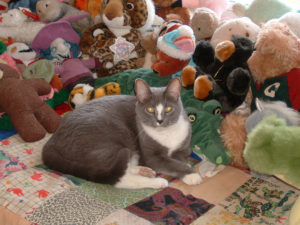One of the biggest challenges we face when working with pets in a hospice situation is the fact that we are no longer dealing with curable diagnoses. Because of this, we know that no matter what we do, over time their illness and their symptoms will progress. Even pets that are stable and responding well to the treatment that we’re giving them today will eventually start to show more signs of illness, or develop additional problems or side effects.
Part of managing this challenging situation is keeping in close touch with your hospice veterinarian, and monitoring your pet closely – while it may seem unusual to ask for frequent check-ins, especially if your pet seems comfortable at the moment, such careful attention lets us stay on top of any subtle changes that may indicate a need to adapt our treatment plan. But an equally important facet of hospice care is planning ahead for those changes and potential emergencies.
Sometimes the progression of symptoms can be slow and subtle – a pet’s appetite may gradually decrease, so that they need coaxing to eat; their arthritis may cause more discomfort over time, so that they get tired more quickly on their walks or start needing help on the stairs again. But sometimes we can be confronted with sudden, drastic changes in a pet’s condition on an emergency basis. The best thing you can do to help manage either of these situations is to talk to your veterinarian in advance, and plan for how you will manage in such potential situations.
The best plan will vary widely depending on your pet’s diagnosis, their temperament, your home environment, and your own resources and abilities when caring for them. The first step in preparing, though, is always going to be talking to your vet about their specific diagnosis or condition. Make sure that you have an understanding of what is going on in your pet’s body, how it is likely to progress over time, what signs to watch for, and what possible complications may arise. The more educated and aware you are, the earlier you will be able to recognize changes – potentially preventing an emergency by acting earlier. Also, being informed can help you feel more confident and prevent you from feeling panicked or overwhelmed in a challenging situation.
Then, based on your conversations and understanding, you and your vet can put together any necessary plans. A plan for slow progression may involve discussing whether you can safely increase the dose or frequency of specific medications based on the severity of your pet’s symptoms; monitoring your pet’s vital signs and adjusting their care plan in response; keeping anti-nausea medication on hand for a pet with GI or kidney disease, or many other similar simple adjustments to their existing care. Emergency plans can range from having an Emergency Kit on hand with single, pre-measured doses of anti-seizure medications or strong pain killers; having an oxygen concentrator and mask on hand in case of difficulty breathing; or having access to a 24-hour nurse or vet tech to help with care if you are unable to be present.
Each plan, of course, must be tailored to your own pet and your own situation, and your vet must be an active part of both planning and enacting it – while it should go without saying, never change your pet’s medication or treatment plan without consulting your veterinarian first! While some medications can be safely increased or decreased, others can be very dangerous to change; your vet will help you decide what is best for you and your pet. Whatever plan you put in place, make sure to keep it written down for your own reference, and review it with your vet at each visit to make sure that it doesn’t need to be changed or adjusted.
It’s scary and hard to think about our beloved pets getting sicker, especially when we’ve gotten them to a stable, comfortable point, and we can never be so thorough that we can be completely prepared for every possible emergency, but all the same, the more we can plan the better we can maintain the creatures that we love and care for in comfort for as long as possible.

 share memories, pictures, and stories here in honor of our beloved pets.
share memories, pictures, and stories here in honor of our beloved pets.